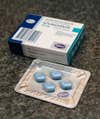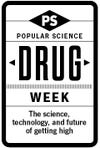FYI: How Does A Drug Get Its Name?
Street names aside, who comes up with crazy non-words like Zyrtec, tenofovir and Xeljanz?


Viagra

Drug Week
Say it with me: Xeljanz. OK, at least try and say it with me. Shell-jance? Zell-johns? Ghel-yahns? Who knows. It’s a new arthritis drug, and I have no idea how to pronounce it, but one thing is definitely clear: It could be worth billions for its maker, Pfizer. (That name you probably know how to say.)
Though awkward to pronounce, Xeljanz is more memorable than its generic name, tofacitinib citrate. And it’s much more noteworthy than its chemical name, some unpronounceable string of characters. When the patent expires on Xeljanz a long time from now, people will ask their doctors for tofacitinib citrate instead.
Drugs, in other words, have at least three names. And coming up with these names, both a chemical name and its commercial brand, requires a drug name decoder. It’s somewhat like learning English words based on their roots: Once you know bio comes from the Greek for life, you know biosphere, biology, biography and so on have to do with that subject.
For drugs, the key is chemistry. Drug makers propose generic names according to their compound’s chemical makeup. While the chemical formula is what truly defines the drug, the name’s stem describes its structure, function and molecular targets. Tofacitinib citrate includes an epidermal growth factor receptor (-nib), which describes how the drug works. Something with a -mab ending, like lots of cancer drugs, are monoclonal antibodies; they target specific cells, viruses or bacteria, and you can identify those by the rest of the name. Something ending in a -vir is, predictably, an antiviral.
As an example, look at tenofovir. This is a drug used to treat HIV infection, and its chemical name is ({[(2R)-1-(6-amino-9H-purin-9-yl)propan-2-yl]oxy}methyl)phosphonic acid. Want to read that over the phone to a pharmacist? Neither does any human anywhere. So instead, the people who discovered it came up with tenofovir. Given the right stem, describing structure and function–the -vir– researchers can tack on syllables of their choice.
While the names sound strange, this is very serious business, according to the Food and Drug Administration. Mis-prescribed drugs are the most common error in health care, and thousands of people die this way every year. New generic names must meet standards set by the World Health Organization’s International Nonproprietary Names (INN) and the United States Adopted Names for pharmaceuticals, and brand names must pass muster with the FDA.
As for commercial names, pharmaceutical companies are reluctant to share their strategies. These are hugely important brands, even after the patents expire–nobody knows what Sildenafil citrate is, but everyone knows its brand name of Viagra. And the odds are you know someone who insists on brand-name Tylenol instead of discount-store acetaminophen.

Truvada
Though pharmaceutical companies contacted by PopSci wouldn’t share their marketing secrets, you can still derive a drug’s molecular and popular heritage just by studying its name. Like, for example, Tylenol. Its chemical name is N-acetyl-p-aminophenol–see the tyl and -ol in there? Then there’s Viagra. It doesn’t sound like sildenafil, but it certainly suggests vigor and virility–exactly what Pfizer wants you to think. Xeljanz, which was approved earlier this year after almost 20 years of research, targets a protein called Janus kinase. It works in a different cellular pathway from other arthritis drugs. That’s where you get the -jan part of that name, which, to someone with a drug decoder, connotes its uniqueness.
As for the Shell, we’ll have to leave that to the imagination.